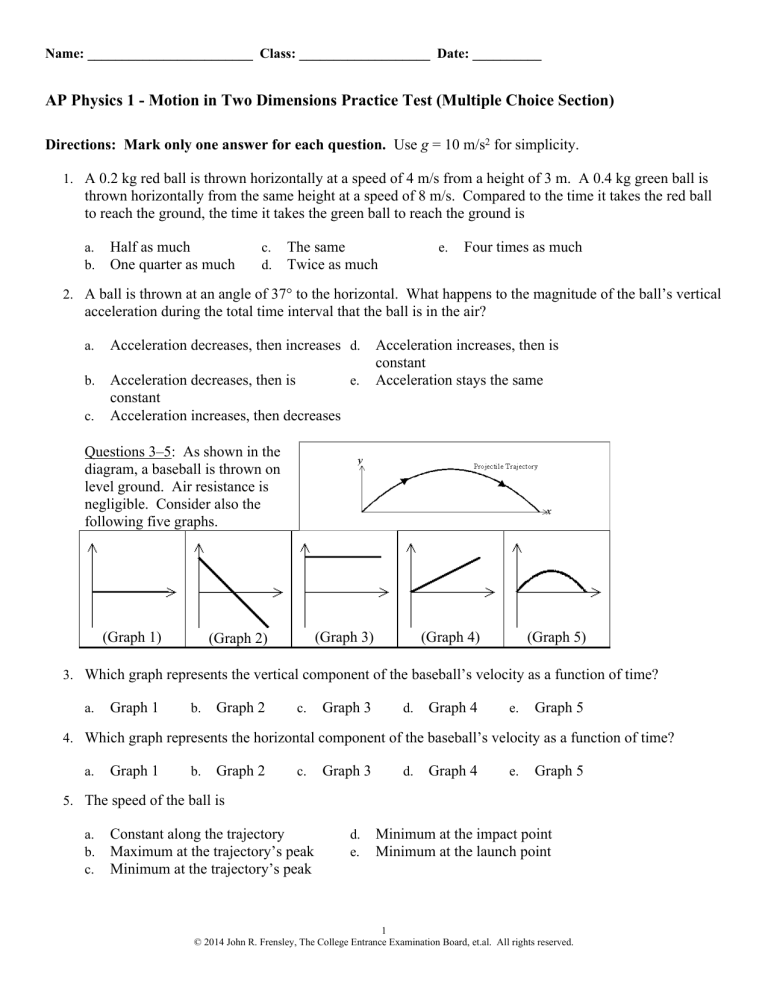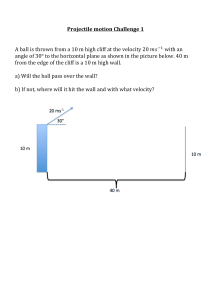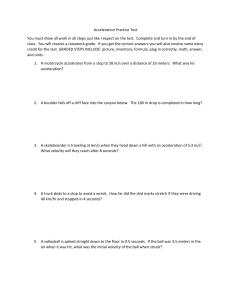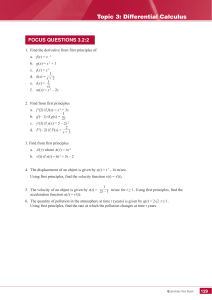
Name: ________________________ Class: ___________________ Date: __________ AP Physics 1 - Motion in Two Dimensions Practice Test (Multiple Choice Section) Directions: Mark only one answer for each question. Use g = 10 m/s2 for simplicity. 1. A 0.2 kg red ball is thrown horizontally at a speed of 4 m/s from a height of 3 m. A 0.4 kg green ball is thrown horizontally from the same height at a speed of 8 m/s. Compared to the time it takes the red ball to reach the ground, the time it takes the green ball to reach the ground is a. b. Half as much One quarter as much c. d. The same Twice as much e. Four times as much 2. A ball is thrown at an angle of 37° to the horizontal. What happens to the magnitude of the ball’s vertical acceleration during the total time interval that the ball is in the air? a. Acceleration decreases, then increases d. b. Acceleration decreases, then is e. constant Acceleration increases, then decreases c. Acceleration increases, then is constant Acceleration stays the same Questions 3–5: As shown in the diagram, a baseball is thrown on level ground. Air resistance is negligible. Consider also the following five graphs. (Graph 1) (Graph 3) (Graph 2) (Graph 4) (Graph 5) 3. Which graph represents the vertical component of the baseball’s velocity as a function of time? a. Graph 1 b. Graph 2 c. Graph 3 d. Graph 4 e. Graph 5 4. Which graph represents the horizontal component of the baseball’s velocity as a function of time? a. Graph 1 b. Graph 2 c. Graph 3 d. Graph 4 e. Graph 5 5. The speed of the ball is a. b. c. Constant along the trajectory Maximum at the trajectory’s peak Minimum at the trajectory’s peak d. e. Minimum at the impact point Minimum at the launch point 1 © 2014 John R. Frensley, The College Entrance Examination Board, et.al. All rights reserved. Questions 6–7: At the top of a building 125 meters high, a dense ball is shot horizontally such that its initial velocity is 20 m/s. 6. How much time elapses before the ball strikes the ground? a. 1 sec b. 2 sec c. 4 sec d. 5 sec e. 6 sec e. 200 m 7. How far from the base of the building will the ball strike the ground? a. 10 m b. 25 m c. 50 m d. 100 m 8. An object that is launched from the top of a tower is dense enough that air resistance can be ignored. The object's initial velocity has components (vx = 60 m/s, vy = 20 m/s). What are the components of the object's velocity 5 seconds after launch? a. b. c. (vx = 10 m/s, vy = –30 m/s) (vx = 10 m/s, vy = 20 m/s) (vx = 60 m/s, vy = –30 m/s) (vx = 60 m/s, vy = 70 m/s) (vx = 110 m/s, vy = 20 m/s) d. e. 9. A ball is shot from ground level with an initial velocity of 250 m/s directed at an angle of 53° to the horizontal. How much time elapses before the ball strikes the ground? a. 20.0 sec b. 25.0 sec c. 30.0 sec d. 40.0 sec e. 50.0 sec 10. What do acceleration and velocity have in common? a. b. c. d. e. Both are scalars. Both are vectors. Both are measured in units of distance divided by time. Both are measured in units of distance divided by time squared. They are different names for the same quantity. 2 © 2014 John R. Frensley, The College Entrance Examination Board, et.al. All rights reserved. Questions 11–12: A ball is launched from ground level with an initial velocity of 250 m/s directed 37° above the horizontal. The ball travels with negligible air resistance over level ground. 11. How fast is the ball moving when it reaches the highest point in its trajectory? a. 0.0 m/s b. 125.0 m/s c. 150.0 m/s d. 200.0 m/s e. 250.0 m/s e. 250.0 m/s 12. How fast is the ball moving just before striking the ground? a. 0.0 m/s b. 125.0 m/s c. 150.0 m/s d. 200.0 m/s Questions 13–14: A projectile is launched over level ground so that its initial velocity has components (vx = 40 m/s, vy = 50 m/s). Ignore the effects of air resistance. 13. How much time elapses before the projectile strikes the ground? a. 4 sec b. 5 sec c. 8 sec d. 10 sec e. 20 sec e. 500 m 14. How far the launch point will the projectile strike the ground? a. 200 m b. 250 m c. 320 m d. 400 m 15. A vector A has magnitude 10, direction 53o, and components (6, 8). What are the magnitude, direction, and components of vector 10A? Magnitude 100 100 10 10 100 a. b. c. d. e. Direction 53o 53o 530o 53o 530o Components (60, 80) (6, 8) (6, 8) (60, 80) (6, 8) 16. When the vectors A, B, and C are added, the result is zero. Which of the following must also equal zero? a. b. A–B–C 2A + 2B + 2C c. d. A+B A+A+B+B e. C–B–A 3 © 2014 John R. Frensley, The College Entrance Examination Board, et.al. All rights reserved. Questions 17–18: A man on a motorcycle is initially at point A. At time t = 0, the man travels along the path shown to point B. The amount of time required to complete each segment of the path is also indicated in the diagram. [Note: The squares in the grid are 10 meters long.] 17. What is the magnitude of the man's displacement once he reaches point B? a. 60 meters b. 80 meters c. 100 meters d. 140 meters e. 200 meters 18. What is the magnitude of the man's average velocity for this travel? a. 1 m/s b. 2 m/s c. 3 m/s d. 4 m/s e. 6 m/s Directions: Mark two answers for each question. 19. Which of the following is/are true? Select two answers. (A) (B) (C) (D) If an object’s acceleration is constant, then it must move in a straight line. If an object’s acceleration is zero, then its speed must remain constant. If an object’s speed remains constant, then its velocity cannot change. If an object’s velocity remains constant, then its speed cannot change. 20. An object that is moving with constant speed travels once around a circular path. Which of the following is/are true concerning this motion? (A) (B) (C) (D) The displacement is zero. The distance is zero. The average velocity is zero. The average speed is zero. 4 © 2014 John R. Frensley, The College Entrance Examination Board, et.al. All rights reserved. ID: A AP Physics 1 - Motion in Two Dimensions Practice Test (Multiple Choice Section) Answer Section MULTIPLE CHOICE 1. C If both balls are thrown from the same height horizontally, they will both strike the ground at the same time (because all of the vertical variables are the same). Also note that vertical acceleration (9.8 m/s 2) does not depend on mass. ⎯⎯⎯⎯⎯⎯⎯⎯⎯⎯⎯⎯⎯⎯⎯⎯⎯⎯⎯⎯⎯⎯⎯⎯⎯⎯⎯⎯⎯⎯⎯⎯⎯⎯⎯⎯ 2. E In projectile motion (which is free-fall), the acceleration is always 9.8 m/s 2 down, so the acceleration stays the same during the entire flight. ⎯⎯⎯⎯⎯⎯⎯⎯⎯⎯⎯⎯⎯⎯⎯⎯⎯⎯⎯⎯⎯⎯⎯⎯⎯⎯⎯⎯⎯⎯⎯⎯⎯⎯⎯⎯ 3. B The vertical component of the ball’s velocity obeys the equation v y = − gt + v0 y . This equation is a line with a slope of –g and an intercept of v0y. The negative slope means the graph can only be Graph 2. ⎯⎯⎯⎯⎯⎯⎯⎯⎯⎯⎯⎯⎯⎯⎯⎯⎯⎯⎯⎯⎯⎯⎯⎯⎯⎯⎯⎯⎯⎯⎯⎯⎯⎯⎯⎯ 4. C The horizontal component of the ball’s velocity is constant and not zero, and Graph 3 is the graph of a constant but non-zero function. ⎯⎯⎯⎯⎯⎯⎯⎯⎯⎯⎯⎯⎯⎯⎯⎯⎯⎯⎯⎯⎯⎯⎯⎯⎯⎯⎯⎯⎯⎯⎯⎯⎯⎯⎯⎯ 5. C The speed of the ball is never zero, but decreases on the way up and increases on the way down. Since it decreases on the way up, speed is the least at the peak of the trajectory. ⎯⎯⎯⎯⎯⎯⎯⎯⎯⎯⎯⎯⎯⎯⎯⎯⎯⎯⎯⎯⎯⎯⎯⎯⎯⎯⎯⎯⎯⎯⎯⎯⎯⎯⎯⎯ 6. D y = ½gt2 (125) = (5)t2 (25) = t2 t = 5 sec ⎯⎯⎯⎯⎯⎯⎯⎯⎯⎯⎯⎯⎯⎯⎯⎯⎯⎯⎯⎯⎯⎯⎯⎯⎯⎯⎯⎯⎯⎯⎯⎯⎯⎯⎯⎯ 7. D x = vt x = (20)(5) x = 100 meters ⎯⎯⎯⎯⎯⎯⎯⎯⎯⎯⎯⎯⎯⎯⎯⎯⎯⎯⎯⎯⎯⎯⎯⎯⎯⎯⎯⎯⎯⎯⎯⎯⎯⎯⎯⎯ 8. C Gravity subtracts 10 m/s every second from the vertical velocity. The vertical velocity is 20 m/s initially, but over the course of 5 seconds, gravity takes away a total of 50 m/s. This makes the vertical velocity –30 m/s, and the horizontal velocity is totally unchanged. ⎯⎯⎯⎯⎯⎯⎯⎯⎯⎯⎯⎯⎯⎯⎯⎯⎯⎯⎯⎯⎯⎯⎯⎯⎯⎯⎯⎯⎯⎯⎯⎯⎯⎯⎯⎯ 1 © 2014 John R. Frensley, The College Entrance Examination Board, et.al. All rights reserved. ID: A 9. D First, find the vertical initial velocity of the ball: vy = v0sin(θ) = (250)(0.8) = 200 m/s Because the ball travels over level ground, the vertical velocity changes from 200 m/s to –200 m/s, a total change of 400 m/s. Gravity subtracts 10 m/s from the vertical velocity every second, so this trajectory takes 40 seconds to travel. ⎯⎯⎯⎯⎯⎯⎯⎯⎯⎯⎯⎯⎯⎯⎯⎯⎯⎯⎯⎯⎯⎯⎯⎯⎯⎯⎯⎯⎯⎯⎯⎯⎯⎯⎯⎯ 10. B Velocity and acceleration are vectors. Only velocity is measured as distance/time, and acceleration is distance/time2. They are not the same quantity. ⎯⎯⎯⎯⎯⎯⎯⎯⎯⎯⎯⎯⎯⎯⎯⎯⎯⎯⎯⎯⎯⎯⎯⎯⎯⎯⎯⎯⎯⎯⎯⎯⎯⎯⎯⎯ 11. D At the highest point, the ball's speed is entirely horizontal. That means that the ball's speed is equal to the horizontal component of its initial velocity: vx = v0cos(θ) = (250)(0.8) = 200 m/s. ⎯⎯⎯⎯⎯⎯⎯⎯⎯⎯⎯⎯⎯⎯⎯⎯⎯⎯⎯⎯⎯⎯⎯⎯⎯⎯⎯⎯⎯⎯⎯⎯⎯⎯⎯⎯ 12. E If a ball is launched over level ground, it strikes the ground with the same speed that it leaves the ground. ⎯⎯⎯⎯⎯⎯⎯⎯⎯⎯⎯⎯⎯⎯⎯⎯⎯⎯⎯⎯⎯⎯⎯⎯⎯⎯⎯⎯⎯⎯⎯⎯⎯⎯⎯⎯ 13. D Because the projectile is launched over level ground, the vertical component of the projectile's motion goes from 50 m/s to –50 m/s. This is a change of 100 m/s. Gravity subtracts 10 m/s of vertical velocity every second, so to take away 100 m/s of vertical velocity, gravity requires 10 seconds. ⎯⎯⎯⎯⎯⎯⎯⎯⎯⎯⎯⎯⎯⎯⎯⎯⎯⎯⎯⎯⎯⎯⎯⎯⎯⎯⎯⎯⎯⎯⎯⎯⎯⎯⎯⎯ 14. D The projectile travels for 10 seconds. Use (distance) = (velocity)(time); to find the horizontal distance, use the horizontal velocity. (Distance) = (40)(10) = 400 meters. ⎯⎯⎯⎯⎯⎯⎯⎯⎯⎯⎯⎯⎯⎯⎯⎯⎯⎯⎯⎯⎯⎯⎯⎯⎯⎯⎯⎯⎯⎯⎯⎯⎯⎯⎯⎯ 15. A Multiplying a vector by 10 multiplies the magnitude AND multiplies both components. However, the vector’s direction does not change if the thing we multiply by is positive. ⎯⎯⎯⎯⎯⎯⎯⎯⎯⎯⎯⎯⎯⎯⎯⎯⎯⎯⎯⎯⎯⎯⎯⎯⎯⎯⎯⎯⎯⎯⎯⎯⎯⎯⎯⎯ 16. B If A + B + C = 0, then doubling the left-hand-side must also equal zero: 2(A + B + C) = 0 2A + 2B + 2C = 0 ⎯⎯⎯⎯⎯⎯⎯⎯⎯⎯⎯⎯⎯⎯⎯⎯⎯⎯⎯⎯⎯⎯⎯⎯⎯⎯⎯⎯⎯⎯⎯⎯⎯⎯⎯⎯ 17. C Point B is displaced from point A by going left 80 meters and up 60 meters. The magnitude of the displacement is the length of the path from A straight to B, which is 100 using the Pythagorean theorem. ⎯⎯⎯⎯⎯⎯⎯⎯⎯⎯⎯⎯⎯⎯⎯⎯⎯⎯⎯⎯⎯⎯⎯⎯⎯⎯⎯⎯⎯⎯⎯⎯⎯⎯⎯⎯ 18. A (Average Velocity) = (Total Displacement)/(Total Time) (Average Velocity) = (100)/(100) (Average Velocity) = 1 m/s ⎯⎯⎯⎯⎯⎯⎯⎯⎯⎯⎯⎯⎯⎯⎯⎯⎯⎯⎯⎯⎯⎯⎯⎯⎯⎯⎯⎯⎯⎯⎯⎯⎯⎯⎯⎯ 2 © 2014 John R. Frensley, The College Entrance Examination Board, et.al. All rights reserved. ID: A OTHER 19. B&D (A) No, a projectile (for example) has a constant acceleration of 9.8 m/s2 downward, but follows a parabolic path if it is launched with a non-vertical initial velocity. (B) Yes, if an object has zero acceleration, then the velocity (speed and direction both) must be constant. Zero acceleration means the object cannot speed up, slow down, or change direction. (C) No, an object can have a constant speed but be changing direction (meaning it has a changing velocity since direction changes). (D) Yes, if an object’s velocity (both speed and direction) remain constant, then the speed cannot change. ⎯⎯⎯⎯⎯⎯⎯⎯⎯⎯⎯⎯⎯⎯⎯⎯⎯⎯⎯⎯⎯⎯⎯⎯⎯⎯⎯⎯⎯⎯⎯⎯⎯⎯⎯⎯ 20. A&C (A) The displacement is zero because the object comes back to its starting point. (B) The distance is not zero because the object traveled a path that had some length. Distance is the length of the path traveled. (C) Average velocity = displacement over time, and with zero displacement, there is zero average velocity. (D) Average speed = distance over time, and with non-zero distance, there is non-zero average speed. ⎯⎯⎯⎯⎯⎯⎯⎯⎯⎯⎯⎯⎯⎯⎯⎯⎯⎯⎯⎯⎯⎯⎯⎯⎯⎯⎯⎯⎯⎯⎯⎯⎯⎯⎯⎯ 3 © 2014 John R. Frensley, The College Entrance Examination Board, et.al. All rights reserved.







